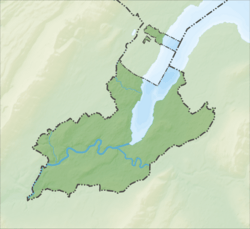Collex-Bossy facts for kids
Quick facts for kids
Collex-Bossy
|
||
|---|---|---|
|
||
| Country | Switzerland | |
| Canton | Geneva | |
| District | n.a. | |
| Area | ||
| • Total | 6.89 km2 (2.66 sq mi) | |
| Elevation | 440 m (1,440 ft) | |
| Population
(Dec 2020 )
|
||
| • Total | 1,686 | |
| • Density | 244.70/km2 (633.8/sq mi) | |
| Postal code |
1239
|
|
| Surrounded by | Genthod Bellevue, Ferney-Voltaire (FR-01), Ornex (FR-01), Versoix, Versonnex (FR-01) | |
Collex-Bossy is a small and interesting municipality in the Canton of Geneva, Switzerland. It's a place where history meets modern life, with beautiful natural areas and a friendly community. This guide will tell you all about Collex-Bossy, from its past to how people live there today.
Contents
Collex-Bossy: A Look at Its Past
Collex-Bossy has a long history! The two main parts of the municipality, Collex and Bossy, were first written about in the year 1258. Back then, Collex was known as Coliacum, and Bossy was called Bocium.
Early Days and Changes
For a period between 1790 and 1855, the nearby village of Bellevue was also part of Collex-Bossy. This shows how the borders of towns can change over time.
The First Airfield
Did you know that Collex-Bossy was once a pioneer in aviation? In 1911, not long after airplanes were invented, one of Switzerland's very first aerodromes (a simple airport) was built here. It had grass runways and places to keep the planes. However, it was only used for a few years. Later, in 1919, there were plans to build a big, modern airport in Collex-Bossy. But in the end, the airport was built in a different nearby area called Cointrin instead.
Where is Collex-Bossy?
Collex-Bossy is located in a lovely spot in Switzerland. It sits on the right side of the Versoix river and is right next to the border with France.
Land Use and Nature
The municipality covers an area of about 6.89 square kilometers (about 2.66 square miles). A large part of this land, about 64.2%, is used for farming. This means you'll see many fields and farms around. About 24.8% of the area is covered by forests, which are great for nature and walks. The rest of the land is used for buildings, roads, and a small amount of rivers.
Villages of Collex-Bossy
Collex-Bossy is made up of several smaller villages and areas. These include Bossy, La Rosière, La Bâtie, La Foretaille, and Collex. Each of these parts adds to the unique feel of the municipality.
Who Lives in Collex-Bossy?
Collex-Bossy is home to a growing number of people. As of 2022, the population is around 1,900 residents. The number of people living here has increased quite a bit over the last ten years!
Languages Spoken
Most people in Collex-Bossy speak French, which is the main language in this part of Switzerland. However, you'll also find many people who speak English, and some who speak German. This shows how diverse the community is.
Community Life
The population of Collex-Bossy includes both Swiss citizens and people from other countries. The community is made up of families, single people, and seniors, creating a mix of different ages and backgrounds. Many people who live here were born in the area, while others have moved from different parts of Switzerland or from abroad.
The historical population is shown in the chart below, showing how the number of residents has changed over the years:

Working in Collex-Bossy
Collex-Bossy has a mix of different jobs and businesses. Many people work in farming, which is part of the primary economic sector. There are also jobs in manufacturing and construction, which are part of the secondary sector. The biggest number of jobs are in the tertiary sector, which includes things like sales, transportation, hotels, restaurants, education, and healthcare.
Commuting for Work
Many people who live in Collex-Bossy travel to other towns for work. This is called commuting. Most people use a private car to get to their jobs, but some also use public transportation.
Education in Collex-Bossy
Education is important in Collex-Bossy. Many adults have completed high school, and a good number have gone on to university or other higher education programs.
School System
The school system in the Canton of Geneva, where Collex-Bossy is located, offers different levels of schooling:
- Kindergarten: Young children can attend two years of non-required kindergarten.
- Primary School: Students then go to six years of primary school.
- Secondary School: After primary school, there are three years of required lower secondary school, followed by optional advanced schools.
Many students from Collex-Bossy attend schools within the municipality, while others travel to schools in nearby areas.
Religion in Collex-Bossy
The people of Collex-Bossy follow different religions. The largest groups are Roman Catholic and Swiss Reformed Church members. There are also smaller communities of other Christian churches, Islamic, and Buddhist faiths. Some people do not belong to any church.
See also
 In Spanish: Collex-Bossy para niños
In Spanish: Collex-Bossy para niños




